
The Miles M.14 Magister is a two-seat monoplane basic trainer aircraft designed and built by the British aircraft manufacturer Miles Aircraft. It was affectionately known as the Maggie. It was authorised to perform aerobatics.
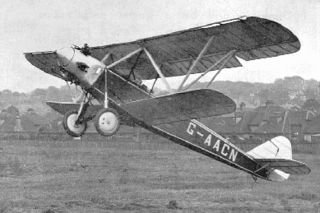
The Handley Page H.P.39 is a wooden biplane that was constructed in 1929. The aircraft was intended to compete in a competition proposed by the Daniel Guggenheim Fund for the Promotion of Aeronautics - the Guggenheim Safe Aircraft Competition. The original working name for the aircraft was the Guggenheim Competition Biplane. The name Gugnunc was at first unofficial, coming from the Pip, Squeak and Wilfred newspaper cartoon, but it later became official.
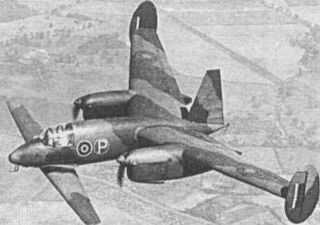
The M.39B Libellula was a Second World War tandem wing experimental aircraft built by Miles Aircraft, designed to give the pilot the best view possible for landing on aircraft carriers. A scale version of the M.39 design was proposed by Miles to meet Air Ministry specification B.11/41 for a fast bomber. The M.39B was used by Miles to generate data from which the M.39 design was improved, but the M.39 project was cancelled and the M.39B broken up.
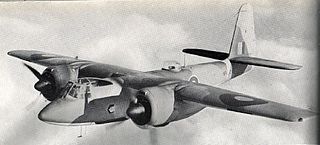
The Miles M.33 Monitor was a twin-engined British target tug aircraft designed and built by Miles Aircraft towards the end of the Second World War. Intended for use by the Royal Air Force and the Fleet Air Arm, the aircraft did not enter service with either.
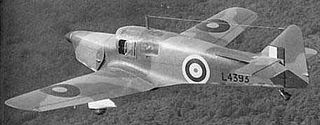
The Miles M.16 Mentor was a 1930s British single-engined three-seat monoplane training and communications aircraft built by Miles Aircraft Limited.

The Auster J/4 was a 1940s British single-engined two-seat high-wing touring monoplane built by Auster Aircraft Limited at Rearsby, Leicestershire.

The Auster J/1U Workmaster is a late 1950s British single-engined single-seat high-wing agricultural monoplane built by Auster Aircraft Limited at Rearsby, Leicestershire. Of traditional high-wing layout, it carries 90 gallons of spray fluid in a tank beside the pilot, an extra seat being provided for a passenger. The Lycoming 0-360-A engine of 180 h.p. driving a McCauley v.p. propeller giving it ample power; and slotted ailerons and balanced tail controls providing good handling. Oversize tyres were fitted. Take-off run at 2,550 lb gross weight and cruising speed at 65 per cent power are respectively 180 yd and 88 miles per hour (142 km/h). Britten-Norman spray gear was provided by Crop Culture, and this company ordered nine Workmasters.

The Percival Merganser was a light, civil transport of the late 1940s. It was a twin-engine, high-wing monoplane of all-metal, stressed skin construction with retractable tricycle undercarriage.

The Miles M.28 Mercury was a British aircraft designed to meet the need for a training and communications plane during the Second World War. It was a single-engined monoplane of wooden construction with a twin tail and a tailwheel undercarriage with retractable main units.

The Central Centaur IIA, a.k.a. Central C.F.2a, was a British civil six-passenger joyriding biplane aircraft produced by Central Aircraft Company Limited of London.

The Avro 641 Commodore was a British single-engine five-seat cabin biplane built by Avro in the mid-1930s for private use. A total of only six were built, including the prototype.
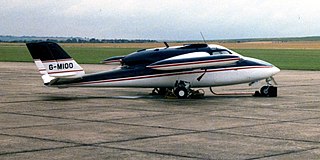
The Miles M.100 Student was built as a lightweight trainer as a private venture by F.G. and George Miles with development started in 1953. Although not specifically a Miles product, it was promoted as a British Royal Air Force trainer but failed to enter production.

The BAT F.K.24 Baboon was a British two-seat training biplane produced by British Aerial Transport Company Limited of London during World War I.

The Miles Hawk Trainer was a 1930s British two-seat training monoplane designed by Miles Aircraft Limited.

The Miles M.1 Satyr was a 1930s British single-seat aerobatic biplane designed by F.G. Miles and built for him by George Parnall and Company.

The Miles M.4A Merlin was a 1930s British five-seat cabin monoplane built by Miles Aircraft Limited.
The Miles M.6 Hawcon was a 1930s British experimental monoplane designed by Miles Aircraft Limited. The Hawcon name comes from a combination of Hawk and Falcon.

The Miles M.7 Nighthawk was a 1930s British training and communications monoplane designed by Miles Aircraft Limited.
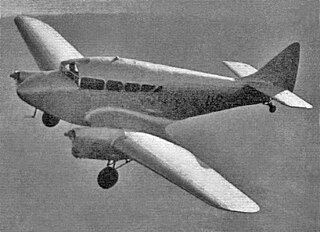
The Miles M.8 Peregrine was a 1930s British twin-engined monoplane light transport designed by Miles Aircraft Limited. A promising design, the Peregrine never entered production as the company was preoccupied by fulfilling orders for other types to the RAF. Only two of the model were built, one prototype M.8 Peregrine, and one modified M.8A Peregrine II which was used for experimentation work at Royal Aircraft Establishment.

The Miles M.65 Gemini was a British twin-engined four-seat touring aircraft designed and built by Miles Aircraft at Woodley Aerodrome. It was the last Miles aircraft to be produced in quantity.



















